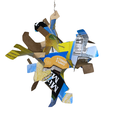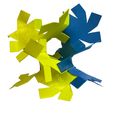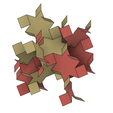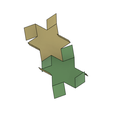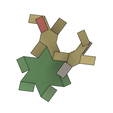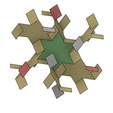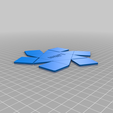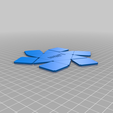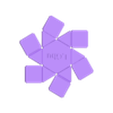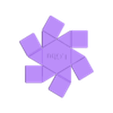Template for the HeXquare Gyroid Paper Model: (6.3^2.4.3)_G
A uniform ps of the gyroid G: Just staple the squares!
Update: The name "HeXquare Gyroid" was invented by Reiko and approved by Alan. Initially, I used the word "skeletal," which Alan thought was wrong. So Reiko came upon the new term "HeXquare Gyroid", which I think represents the basic structure of the paper model. So here it goes -- HeXquare Gyroid .
Interested in making a paper model for the Gyroid out of a few cereal boxes (or their equivalents)? Here is a template based on Schoen’s original models and Weber’ tweaks. The component regular polygons (triangle, square, hexagon) have a side length of 30mm; the whole template has a radius of 71.83mm. It can be placed on any cardboard for tracing and cutting. It takes 14 pieces to make a cubic unit cell; and it can grow as long as you have time for! Do feel free to scale it up or down to suit your needs. If printed using TPU flexible filament or PETG, the 3D-printed templates can be used to construct a gyroid model.
I do have a complete surface model, as shown in the pictures. However, it is not easy to print. The paper model is the best for educational purposes.
####How To: Be Patient and Try it Out One Piece at a Time
1. Print a template and trace-cut 14 pieces out of some cereal boxes. Be consistent with your orientation of the cardboard and template IF you want to see all the colors on one side. Otherwise, it does not matter.
2. With each cutout star, bend 3 square up and the other 3 down in an alternating pattern. The angle is not important for a paper model. If you ask me, the angle is about 54.7 degrees or arccos(1/sqrt(3)).
3. Start with two stars, tilt one with respect to the other, allowing an up-square to overlap with a down-square and the triangles to touch each other. Staple the overlapping squares.
4. Add a third one to the center hex-star, this third one will point in a different direction from the second one (in an up-down-up-down-up-down) pattern. Staple the overlapping squares.
5. Go round the center star and finish one half of the model using 7 pieces.
6. Make another half using the same strategy.
7. Take two halves, flip one onto the other, allowing the stars to naturally touch each other (feel free to rotate for find the fit). Staple the overlapping squares, using glue if you cannot reach the inside squares.
8. Note that, wherever the model is complete, the squares will have 4 layers.
9. It is hard to describe in words or even pictures. You got to do it to grasp the beauty of the geometric patterns.
10. Do look at the pictures I uploaded in addition to Schoen’s and Weber’s.
####Story behind the Design
Ms. Reiko Schoen and I tried to bring the paper model of the gyroid to a group of children. We tried Weber’s templates first. They worked. However, we had a hard time gluing the pieces together. It takes a lot of tape or glue! Then, I showed my paper model to a graduate student (Ms. Y. Liu) at SIUC, who recommended that I keep the squares on the hexagonal star. Well, I gave it a try using cardstock paper. I found that we do not need to glue them any more. We can just staple the squares. And that saves a lot of time. Then, I got curious and made a 3D printable template for tracing on cereal boxes. Cereal boxes (or similar) have the right rigidity for the project but do not lend themselves to a printer. The template turns out to be a great tool. One does not have to be super accurate in tracing and cutting. It does take a lot time; but it is now classroom-friendly!
####References
1. Schoen’s Paper Model: https://schoengeometry.com/e-tpms-media/uniform_gyroid_model.pdf
2. Schoen’s gyroid treasure chest: https://schoengeometry.com/e-tpms.html
3. Weber’s templates: https://minimalsurfaces.blog/2018/12/23/make-your-own-gyroid/

/https://fbi.cults3d.com/uploaders/13405687/illustration-file/2c3da4ee-d924-419e-b803-49fd899af6b0/6f8ef40a-d7d1-4111-b714-a9706922b0ae.PNG)
